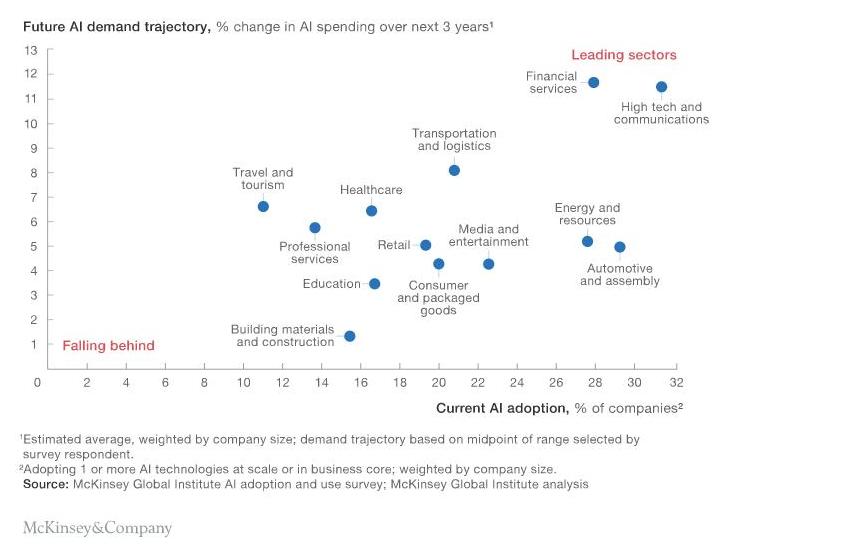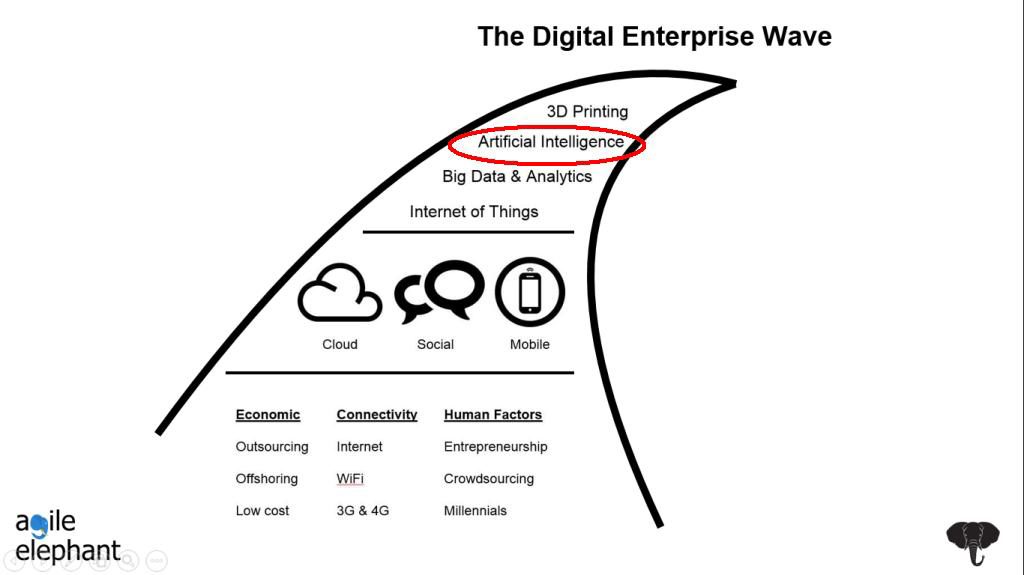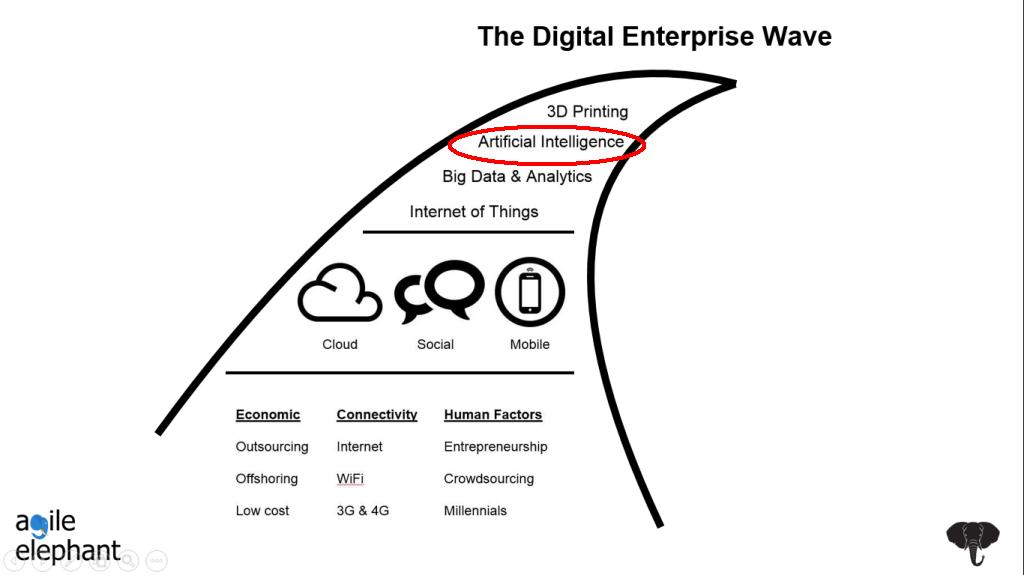People may recall in 2014 we set up our Digital Wave model (see picture above). At the time we identified Mobile, Social and Cloud as trends that would shape the next few years of Digital Transformation. That is playing out now much as predicted, so one of the things we have started to bring more sharply into focus for enterprioses looking at Digital Transformation is how to think about using the next “wave” using our “What Works, What Doesnt, What’s Next” approach.
Our current focus is Professional Service businesses and our support of the Global Legal Hackathon so this post is focussed on that arena – interestingly enough, McKinsey recently put this sector (and themselves, by extension?) as laggards in AI adoption (See chart below and this report) – this despite news of AI taking over low level legal roles, introduction into marketing and customer service roles etc.
This post is an initial analysis of opportunities and managing reviews in Artificial Intelligence (AI) as early systems start to come into range of being useful to enterprises other than the big data analytics based businesses like Google and Facebook. To say the sector is overhyped is putting it mildly, but there are some babies among the frothy bathwater, but hopefully we can sort the wheat from the crap.
What Works
Maybe a better term for AI is “Automated Intelligence” – essentially it is just another wave of (digital) automation, chipping away at “white collar” knowledge work, just at the next level up compared to the previous waves. And as with all automation, it is initially being used to automate work that is simple and has:
- Bounded Solutions – Most useable AI is today is what is better termed “machine learning” or “deep learning”. To be honest, when I was at Uni few decades ago these weren’t considered “AI” at all – there has been hype creep. But in essence “Machine Learning” systems are very bounded closed loop systems – machines – that have a limited ability to adjust their processes and outputs to react to new inputs. “Deep Learning” is reall better termed “Pattern Recognition” – it’s the ability of IT systems to just crunch far more data and find relationships in the data that humans don’t have the time to do. “General purpose” AI – AI that can learn on it’s own – is still a long way from being usable in most situations.
- Easy to Automate – rote tasks, with simple workflows and minimal variation, that are easy to write rules for and replicate in software. AI is the took that hadles that bit more variation and workflow complexity
- Worth Automating – this is important – the economics of replication have to be considered, If it can be done for less by people it will be as a human still has a higher functioning AI computer than anything yet built, Where AI comes into it’s own is that it can work 24x7x365, and makes fewer errors with repetitive tasks.
In a way, AI is more useful compared to past “AI revolutions” that failed since today, because there is more digital real estate in most enterprises, it is easier to find work for AIs to work on – so we expect a lot of the first “AI” systems to be used to automate existing digital workflows in enterprises.
What Doesn’t Work
Many of the pronouncements about AI capabilities today won’t be around for years, if not decades. There are a number of major barriers today:
- Vertical Variability – Modern AI is still very simple, they can only really work in very tightly defined verticals where variability in conditions is low or else the environment becomes too complex (This is what has killed all previous AI “hot tech” cycles, not computer power). This why all the “gee whiz” comes from AI in games like Go and Chess, which have very constrained variability and a bounded solution space. The question for large scale deployment is always “is this vertical big enough/valuable enough per workpiece to make it worth throwing expensive automation at it.”
- GIGO (Garbage In, Garbage Out) – the same problem that besets Analytics besets AI – today’s systems have no judgement of context outside the narrow area they are aimed at, so data has to be very carefully scrubbed, structured and tagged for them to use it without making gross errors. Also, the data has to be more than just clean, it has to be correct to train an AI.
- Volumes – most AI systems need a lot of data to do tjeir thing, many enterprises bven in teh days of Big Data don’t have enough in all the necessary areas in a workflow for AT to be useful.
- Developing and training AI’s is hard and expensive – very time consuming and needs high levels of expertise. Parenting a living infant is hard and a near full time job, for a long time. Ditto an AI system. As with live infants, the simpler the organism the less the time and work needed – but the less it is capable of. Some types of AIs can self learn very well against datasets (genetic algorithms, neural networks for example) but having used these in the past I know one quickly hits the Vertical Variability and GIGO problems
What’s Next
No doubt the technology will continue to improve, but when we look at what will be adopted in teh near future, a few clear rules emerge:
- It will have to be in high value verticals – we expect a lot of early uses will be to automate existing digital systems and workflows in high value industries.
- But these verticals will also have to be very predictable with small solution spaces – so think mass production, rote tasks rather than replacing creative roles.
- Many work roles will need to be re-engineered to use AI effectively – many work roles today have a mix of the rote and complex, the predictable and the variable, and it typically is only the “rote and predictable” that can be AI’d away. It’s not worth automating tiny bits of a person’s role, so all previous automation from Winslow Taylor (and before) seeks to split up and redefine the worflow to aggregate the automatable parts.
- It has to be a good deal better than “good enoughs” – this includes human part time effort (Mechanical Turks, Gig Workers, Offfshoring etc) or simply that the AI-able tasks in a role being easily done in the workflow by the existing workers don’t add enough value.
- In addition, we are picking up real concerns about “blind” and biassed” algorithms – so algorithm testing and transparency are going to big issues for deployment, especially into consumer areas. We’d expect to see a lot of AI technologies deployed inter-enterprise first.
It’s no accident therefore that the McKinsey analysis of the industries most advanced in AI (see McKinsey chart below) are IT & Comms (automating existing systems) and Finance (highly valuable benefits of automation). and the next ones are high value Manufacturing, Logistics and Energy which have been the main recipients of previous automation waves.- these are all very rules based industries, with fairly bounded processes and relatively well defined workflows. Note for example Aerospace isn’t in there in the vanguard – it’s a lot harder to automate, we can tell you!
 So what of professional services and AI? Note that they are a laggard in the chart above. That’s no real surprise to us, professional services have proven very difficult to automate in the past as the work – although often very valuable – is highly variable, and the solution space is highly unbounded. If previous lessons from automation in these industries are anything to go by it’s largely the support services and rote work that are automated, so we would expact AI to come into areas that have already seen IT inroads such as:
So what of professional services and AI? Note that they are a laggard in the chart above. That’s no real surprise to us, professional services have proven very difficult to automate in the past as the work – although often very valuable – is highly variable, and the solution space is highly unbounded. If previous lessons from automation in these industries are anything to go by it’s largely the support services and rote work that are automated, so we would expact AI to come into areas that have already seen IT inroads such as:
- Knowledge management – everything from document capture, document checking, tagging/labelling, storage, sampling etc.
- Data assembly – searching for data, reports etc and assembling it against requests
- Aids in building presentations, contracts etc – and checking them intelligently for errors
- Load balancing – scheduling people, resources, work packages etc. You can check out McLeod Brock to maintain the perfect schedule to handle things.
- Workflow processes with simple rules – e.g, changing a report or contract for one client to another, one day maybe even expenses (one can dream)
- Recruitment and retention, HR policies, IT support systems, possibly financial support
- Risk analysis (of major risks) – probably financial, contractual and regulatory initially
- Decision support – this is where we predict AI will enter the more creative, “one off” project type work areas, design support – supporting the human experts in the space. Look for very high value tasks to make it worthwhile
But that is more than enough to be getting on with for now…….

